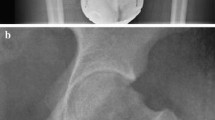Abstract
Objective
To determine whether a 3D magnetic resonance imaging (MRI) sequence with postprocessing applied to simulate computed tomography (CT) (“pseudo-CT”) images can be used instead of CT to measure acetabular version and alpha angles and to plan for surgery in patients with femoroacetabular impingement (FAI).
Materials and methods
Four readers retrospectively measured acetabular version and alpha angles on MRI and CT images of 40 hips from 20 consecutive patients (9 female patients, 11 male patients; mean age, 26.0 ± 6.5 years) with FAI. 3D models created from MRI and CT images were assessed by 2 orthopedic surgeons to determine the need for femoroplasty and/or acetabuloplasty. Interchangeability of MRI with CT was tested by comparing agreement between 2 readers using CT (intramodality) with agreement between 1 reader using CT and 1 using MRI (intermodality).
Results
Intramodality and intermodality agreement values were nearly identical for acetabular version and alpha angle measurements and for surgical planning. Increases in inter-reader disagreement for acetabular version angle, alpha angle, and surgical planning when MRI was substituted for CT were − 2.1% (95% confidence interval [CI], − 7.7 to + 3.5%; p = 0.459), − 0.6% (95% CI, − 8.6 to + 7.3%; p = 0.878), and 0% (95% CI, − 15.1 to + 15.1%; p = 1.0), respectively, when an agreement criterion ≤ 5° was used for angle measurements.
Conclusion
Pseudo-CT MRI was interchangeable with CT for measuring acetabular version and highly favorable for interchangeability for measuring alpha angle and for surgical planning, suggesting that MRI could replace CT in assessing patients with FAI.






Similar content being viewed by others
References
Bredella MA, Ulbrich EJ, Stoller DW, Anderson SE. Femoroacetabular impingement. Magn Reson Imaging Clin N Am. 2013;21(1):45–64.
Ghaffari A, Davis I, Storey T, Moser M. Current concepts of femoroacetabular impingement. Radiol Clin N Am. 2018;56(6):965–82.
Leunig M, Beaule PE, Ganz R. The concept of femoroacetabular impingement: current status and future perspectives. Clin Orthop Relat Res. 2009;467(3):616–22.
Genovese E, Spiga S, Vinci V, et al. Femoroacetabular impingement: role of imaging. Musculoskelet Surg. 2013;97(Suppl 2):S117–26.
Ganz R, Parvizi J, Beck M, Leunig M, Notzli H, Siebenrock KA. Femoroacetabular impingement: a cause for osteoarthritis of the hip. Clin Orthop Relat Res. 2003;417:112–20.
Riley GM, McWalter EJ, Stevens KJ, Safran MR, Lattanzi R, Gold GE. MRI of the hip for the evaluation of femoroacetabular impingement; past, present, and future. J Magn Reson Imaging. 2015;41(3):558–72.
Heyworth BE, Dolan MM, Nguyen JT, Chen NC, Kelly BT. Preoperative three-dimensional CT predicts intraoperative findings in hip arthroscopy. Clin Orthop Relat Res. 2012;470(7):1950–7.
Beaule PE, Zaragoza E, Motamedi K, Copelan N, Dorey FJ. Three-dimensional computed tomography of the hip in the assessment of femoroacetabular impingement. J Orthop Res. 2005;23(6):1286–92.
Yaddanapudi K, Subhas N, Polster J, Goodwin R, Rosneck J. Acetabular version measurements in native hips: comparison between MRI and 2D CT. Skelet Radiol. 2014;43(12):1795–6.
Gyftopoulos S, Yemin A, Mulholland T, et al. 3DMR osseous reconstructions of the shoulder using a gradient-echo based two-point Dixon reconstruction: a feasibility study. Skelet Radiol. 2013;42(3):347–52.
Gyftopoulos S, Beltran LS, Yemin A, et al. Use of 3D MR reconstructions in the evaluation of glenoid bone loss: a clinical study. Skelet Radiol. 2014;43(2):213–8.
Samim M, Eftekhary N, Vigdorchik JM, et al. 3D-MRI versus 3D-CT in the evaluation of osseous anatomy in femoroacetabular impingement using Dixon 3D FLASH sequence. Skelet Radiol. 2019;48(3):429–36.
Obuchowski NA, Subhas N, Schoenhagen P. Testing for interchangeability of imaging tests. Acad Radiol. 2014;21(11):1483–9.
Yan K, Xi Y, Sasiponganan C, Zerr J, Wells JE, Chhabra A. Does 3DMR provide equivalent information as 3DCT for the pre-operative evaluation of adult hip pain conditions of femoroacetabular impingement and hip dysplasia? Br J Radiol. 2018;91(1092):20180474.
Rathnayaka K, Momot KI, Noser H, et al. Quantification of the accuracy of MRI generated 3D models of long bones compared to CT generated 3D models. Med Eng Phys. 2012;34(3):357–63.
Sutter R, Dietrich TJ, Zingg PO, Pfirrmann CW. Femoral antetorsion: comparing asymptomatic volunteers and patients with femoroacetabular impingement. Radiology. 2012;263(2):475–83.
Fritz B, Bensler S, Leunig M, Zingg PO, Pfirrmann CWA, Sutter R. MRI assessment of supra- and Infratrochanteric femoral torsion: association with femoroacetabular impingement and hip dysplasia. AJR Am J Roentgenol. 2018;211(1):155–61.
Acknowledgments
We acknowledge Kavitha Yaddanapudi, MD, and Soterios Gyftopoulos, MD, MSc, for their help with study design and critical revision of the manuscript. We acknowledge Megan Griffiths, ELS, for help with manuscript editing.
Author information
Authors and Affiliations
Corresponding author
Ethics declarations
Ethical approval
All procedures performed in studies involving human participants were in accordance with the ethical standards of the institutional and/or national research committee and with the 1964 Helsinki declaration and its later amendments or comparable ethical standards.
Conflict of interest
The authors declare that they have no conflict of interest.
Additional information
Publisher’s note
Springer Nature remains neutral with regard to jurisdictional claims in published maps and institutional affiliations.
Rights and permissions
About this article
Cite this article
Guirguis, A., Polster, J., Karim, W. et al. Interchangeability of CT and 3D “pseudo-CT” MRI for preoperative planning in patients with femoroacetabular impingement. Skeletal Radiol 49, 1073–1080 (2020). https://doi.org/10.1007/s00256-020-03385-0
Received:
Revised:
Accepted:
Published:
Issue Date:
DOI: https://doi.org/10.1007/s00256-020-03385-0




